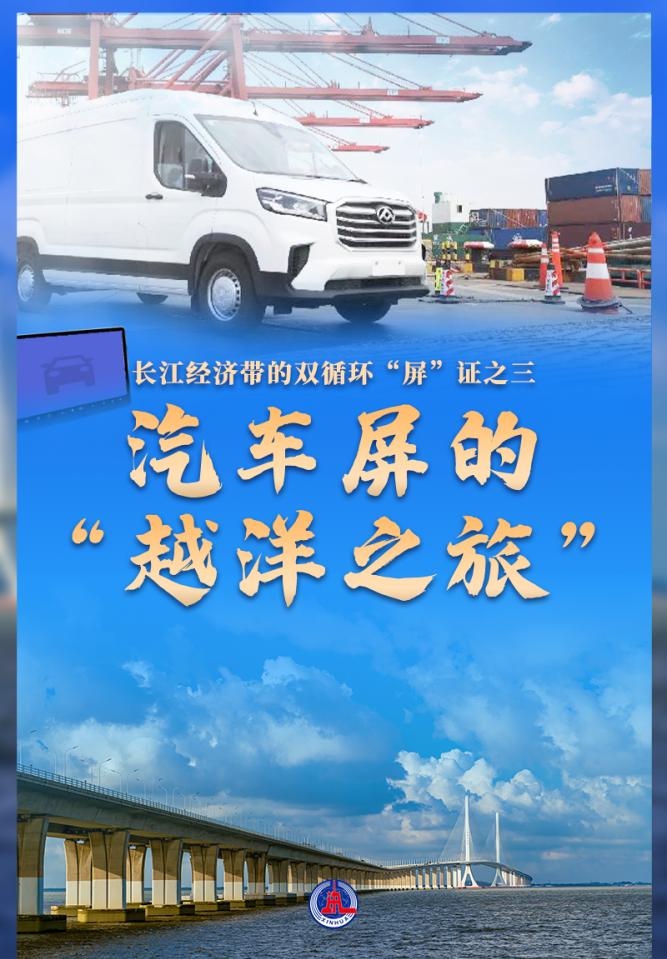
On the first day of the new year, hundreds of SAIC Maxus new energy vehicles equipped with 10.1-inch car screens from Chongqing set off from Shanghai Port, where the Yangtze River meets the Pacific Ocean, to start their own "transoceanic journey". The final destination of this batch of new energy vehicles produced at the Wuxi plant in Jiangsu Province is the market of developed countries in Europe.
Shanghai Waigaoqiao Haitong Wharf "ready to go" export cars. (Xinhua News Agency Photo)
Lan Qingsong, vice president of SAIC Motor, said that new energy vehicles are becoming the "fragrant food" of overseas markets, and in 2021, 90% of the cars sold by SAIC Maxus to the European market will be new energy vehicles. It is worth mentioning that in the markets of developed countries such as Europe, the price of SAIC Maxus is higher than the domestic price.
"The improvement of the strength and brand power of Chinese-made automobile products has enabled the current Chinese automobiles to win the recognition of overseas markets with high quality and high price." Lan Qingsong said that in the Norwegian market, the price of the EV90 VAN model is equivalent to 410,000 yuan to 500,000 yuan, which is nearly double the domestic price.
SAIC Maxus Automobile exported to Europe. (Courtesy of the interviewee)
The Yangtze River Economic Belt is an important agglomeration of China's automobile industry. From Changan Automobile in Chongqing, to Dongfeng Motor in Hubei, Chery Automobile in Anhui, Weilai Automobile, and then to Shanghai Automobile in Shanghai, the Yangtze River Economic Belt not only brings together a large number of automobile brand OEMs, but also brings together various auto parts manufacturers such as display screens, and the new energy vehicles produced and exported here have increasingly become the "golden business card" of China's exports.
You Yongsheng, director of the Foreign Trade Development Department of the Shanghai Municipal Commission of Commerce, said that from January to November 2021, the export value of Shanghai Automobile increased by 37.44 billion yuan over the same period of the previous year, an increase of 224.5%.
Not only automobiles, as China's largest industrial corridor, the Yangtze River Economic Belt also brings together the essence of China's modern industries such as electronics, equipment, and petrochemicals. In the context of the global epidemic, China, which took the lead in resuming work and production, has both supply and demand for many products.
Across the Chinese New Year's Eve, the yard of Shanghai Baoshan Taiping Container Co., Ltd. is brightly lit, and many freight forwarding companies and shipping companies are queuing up to pick up boxes.
"2021 is the hottest market I've seen in my 10 years in the industry." Xu Jinyong, general manager of Shanghai Baoshan Taiping Container Co., Ltd., said that most of the containers produced by enterprises are loaded with export commodities from foreign trade enterprises in the Yangtze River Delta, in order to alleviate the tension of "one box is difficult to find" in the container market, enterprises not only work overtime on the production line, but also specially invest 50 million yuan in technical transformation funds, and purchase CNC cold processing equipment, integrated component production lines, welding robots, spraying robots and other equipment." In December 2021, the company's production capacity reached 22,000 TEUs, far exceeding the 8,500 TEUs in January."
Shanghai Baoshan Taiping Container Co., Ltd. yard just off the production line of containers. (Courtesy of the interviewee)
Production capacity has increased, and export efficiency is also accelerating in "running". Xu Jinyong said that now, the export tax rebate of enterprises can be received within 1 to 2 working days after the declaration is submitted, and the customs clearance of containers has been shortened from the previous 4 to 5 working days to the same day declaration and release on the same day, "We really feel the improvement of government efficiency."
However, scarce containers and soaring maritime prices have also caused many companies to encounter "capacity bottlenecks". To this end, Shanghai has set up a special class for the municipal government's maritime transport capacity guarantee and steady growth, focusing on coordinating and solving the problems of international transportation of export enterprises.
Shen Weihua, deputy director of the Shanghai Municipal Commission of Commerce, introduced that Shanghai supports COSCO SHIPPING to establish a booking platform for small and medium-sized enterprises, provides direct services for small and medium-sized enterprises, and also conducts a special survey on the demand for shipping containers for hundreds of key export enterprises in Shanghai, and will help enterprises recommend 15334 TEUs in 2021.
As the leader of the Yangtze River Economic Belt and an important hub of domestic and international double circulation, for Shanghai, ensuring the smooth flow of domestic and international logistics channels is, in a sense, actively maintaining the stability of the global industrial chain supply chain.
According to the data, from January to November 2021, Shanghai achieved a total value of 3.67 trillion yuan in foreign trade imports and exports, an increase of 16.3% over the same period in 2020. Among them, exports were 1.41 trillion yuan, an increase of 13.3%,; imports were 2.26 trillion yuan, an increase of 18.3%.
Planners: Xie Liang, Yao Yujie, Yang Jinxin
Reporters: Zhou Rui and Gong Wen
Editors: Wang Naishui, Guo Baojiang
Poster Maker: Yang Yiqun